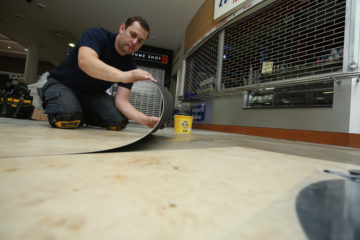Flooring installations in retail environments often face significant pressure to minimise the time that a store is closed or areas have to remain out of service to members of the public. Stephen Boulton, Technical Service Manager at F. Ball, advises on cutting the time it takes to install floorcoverings in these settings without compromising on finished results.
Nowadays, flooring installation products, including waterproof surface membranes, smoothing compounds and adhesives, are available that when used correctly and in combination, allow floorcoverings to be installed in less than a day, whereas it might have once taken several days, leaving areas inaccessible in the meantime.
Achieving a long-lasting, professional flooring finish also requires flooring contractors to follow best practice in subfloor preparation. Before undertaking any flooring installation, a thorough assessment of the subfloor should be completed to ensure it is sound, smooth and free of contaminants.
Moisture management
Unmanaged moisture, whether residual construction moisture or rising damp, is one of the leading causes of floor failure. For this reason, F. Ball recommends that a moisture measurement test should be carried out using a pre-calibrated hygrometer (in accordance with British Standards) to determine the relative humidity (RH) levels of the subfloor as part of any flooring installation.
Where the relative humidity (RH) levels in the subfloor are above 75% (or 65% if wood floorcoverings are to be installed) some form of moisture management solution will be required to prevent excess subfloor moisture damaging floorcoverings and attacking adhesives, potentially causing complete floor failure. A number of timesaving options exist where a solution for excess moisture is required.
Liquid waterproof surface membranes are the usual option, and advanced products are now available that will isolate excess subfloor moisture where relative humidity values are up to 98% with a single coat application and will fully cure in as little as four hours.
A smooth finish
F. Ball recommends the application of a smoothing compound to create a perfectly smooth base for floorcoverings and optimise the finished appearance of an installation.
The fastest setting products on the market are ‘walk-on’ hard in 30 minutes and ready to receive new floorcoverings from 45 minutes. The same products are low-odour, easy to use, self-smoothing and can be applied at thicknesses of up to 10mm.
Where flooring installations are part of a refurbishment and old adhesive residues (including bitumen and carpet tile tackifiers) are present after the removal of old floorcoverings, contractors can save time by using a smoothing compound that has been specially formulated for use over old adhesive residues, which would otherwise require mechanical removal. One such product, Stopgap 1200, takes as little as 60 minutes to set and is ready to receive floorcoverings from just four hours.
Choosing the right adhesive
Once the smoothing compound has cured, the contractor can select a suitably fast-working adhesive to install appropriate floorcoverings. The choice of adhesive will often be determined foremost by what type of floorcoverings are to be installed and where, but there are options for when timesaving is a priority.
Adhesives for vinyl sheet and tile and rubber floorcoverings, such as Styccobond F58 PLUS, allow floorcoverings to be installed from just five minutes after application.
Carpet tile tackifiers are available that only take 30 minutes to form a permanently tacky film, which will prevent tiles from moving laterally under everyday traffic, while allowing individual sections to be easily lifted and replaced if damaged or worn.
Compatibility check
To prevent a substandard finish or even complete floor failure, contractors should always ensure that adhesives are compatible with the chosen floorcoverings. To do this, contractors should consult the adhesive manufacturer’s Recommended Adhesives Guide (RAG®) or see the floorcovering manufacturers’ instructions.
